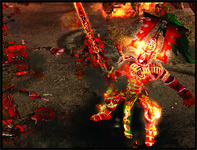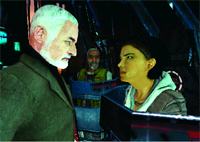The camera is behind the characters, from the knees up, but the game is set up so players can rotate the camera around them at anytime. "I tend not to do a lot with the face right now just because developing on the PS2, and with all the technology we have in Mercenaries, doing facial animation all the time ended up becoming quite a big burden on the hardware. In the beginning, we weren't even going to do facial animation but it was one of the things that I experimented with and found out we could do."
FIFA 2006
The annual soccer release from Electronic Arts Sports (www.ea.com/), FIFA 2006, will next be available in fall '05 for current and next-generation platforms. EA Sports is the creator/publisher.
Most Major League Soccer teams, and their stars, are in the game. There are thousands of characters. Making those players look and move authentically is their trademark - fans want to see their stars. "Our big challenges are not character design, per se, but pulling off a lifelike character that very easily is recognizable as that particular athlete," says senior art director Henry LaBounta. Adds senior animation director Eric Armstrong, "You can't separate [how they look and how they act]. The reality is we spend a lot of time comparing our characters to still photographs so our video references match. But in the end it's really about the experience, how they move and play and act in the game itself as to whether or not they're believable." Animators spend a lot of time analyzing actual motions of individual players.

Relic used 3DS Max 5.1 on Warhammer 40,000.
|
To enhance the believability factor, the new platforms on the horizon - with more powerful processors and memory - have created opportunities for EA animators to apply new techniques to the production process. Paying attention to how fabric moves against players' bodies is one focus. Already, in FIFA 2005 and FIFA Street, there are NIS sequences (non-interactive) where gamers, when not in gameplay, can go down on the field for player close-ups and reaction shots. There is also an instant replay function within gameplay.
Animation is motion captured. Electronic Arts has one of the largest mocap stages in North America. Their mocap system is used with proprietary tools, and Kaydara's Motion Builder, which deal with that data and building complex animation moves suitable for interactive experiences. Alias Maya 6.01 on PCs is used for modeling and animation.
HALF LIFE 2
An action game released in November '04 for PC, Half Life 2 is a Valve Software brand (www.valvesoftware.com/). It is a single-player experience, differing from the developer's other big brand, Counter Strike. In Half Life 2, the research scientist, who unleashed the alien invasion, is joined by a colleague's daughter to fight their nemesis G-Man. The main characters have normal proportions, blemishes, five-o-clock shadows and other realistic imperfections.

Brain Zoos Darkwatch Trailer
|
Story, characters and context are Valve title trademarks. "We're the guys that bring story to the genre, create characters that are able to deliver emotion and messages without having to say a word by developing a really advanced facial animation system," says Lombardi. "When Half Life was put into production [in 1996], it was macho man twitchfest everywhere. The idea was if the shotgun's cool, a double-barrel shotgun's cooler, and a quad-barrel shotgun is the ultimate. We were like, 'Ok, that space is getting crowded, so maybe if we go the other way there would be some value and appeal to people.'"
Valve spent several years producing Half Life 2 with a $40 million budget, investing in technology that included a physics simulation system to run the game. Players are never taken out of the action - there are no cinematics. Character performances are done on the fly by a combination of different animated objects that are controlled by the AI (Artificial Intelligence), broad level commands given by animators and scene designers. Facial acting is blended in. The game was hand animated.
Valve's facial animation system uses 35 key muscle movements authored for each character, with particular focus on the eyes. "One of the fundamental things of our character performances is being able to sell the eyes," says producer Bill van Buren. "In a lot of games, characters look like dolls or plastic puppets, especially if they get more realistic. If they don't get the eyes right it's very off-putting. One of our engineers, Ken Birdwell, did a lot of research on eyes. They actually reflect the lights that are in the room, they change their focal lengths as they're looking at things, like how close or far away they are. And then we also had to model behaviors for when you change your gaze, like if you're going to turn and look at something else, how does it move? Do the eyes lead and the head follow, and the shoulders and body follow that?"
Valve's tools include the proprietary engine with a level editor called Hammer and the facial animation/scene construction program called Face Poser. All basic animation is done in Softimage| XSI; they worked in many versions including betas, says van Buren. Hardware was a mix because it provided compatibility testing for the game.
WARHAMMER 40,000
Released end of '04 for PC, Warhammer 40,000: Dawn of War, was developed by Relic Entertainment (www.relic.com) and published by THQ. It's a realtime strategy game, part of the Warhammer series.
Of the many different races in its universe, Warhammer 40,000: Dawn of War features four, each with its own hierarchy of leader, vehicle and builder units. The Orcs are animalistic, gorilla-like green creatures. Space Marines are military units, armored, human and high-tech. The Eldar are humanoid and nearly weightless. Chaos are Space Marines gone bad. Gamers can play any race. All are constantly under attack.

Valve's Half Life 2, a single-player experience, was animated in Softimage|XSI.
|
"None of this stuff had ever been animated before in a way that we thought did it justice, so we really had a lot of freedom," says lead animator Erich Salloch.
The most complicated animation technique was Relic's synch kill system, which controlled how characters synched up and interacted. "When characters encounter each other and begin to fight hand to hand, once the game determines who's going to lose the battle, they synch up into a final kill where a character may pick up another one and punch him in the head. He'll actually react at the proper time or he'll get thrown," explains Salloch. "We tried to make those very entertaining and big. From an animation standpoint, that was our biggest hurdle, just getting those to work right because every unit in the game is a different size, so you may hit one guy in the stomach but if he's a different size you may hit him in the crotch."
The rest was straightforward keyframe animation, which went smoothly because of strong animators and texturers, no crazy code to write, and an intense preproduction phase. Salloch ignored little details like badges, preferring to capture the essence of each race. Since the camera is 35 meters above ground, gamers often see the characters from fairly far away.
The animators used Discreet 3DS Max 5.1 and Character Studio on Pentium 4 PCs to animate during the 18-month production cycle